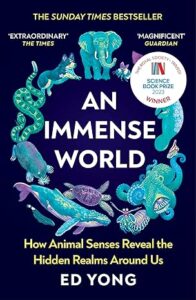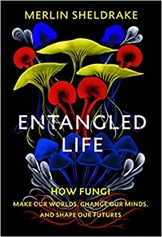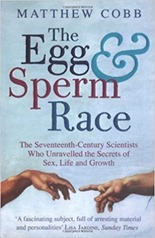My next review is of An Immense World by Ed Yong, subtitled How Animal Senses Reveal the Hidden Realms Around Us. I reviewed Yong’s previous book, I Contain Multitudes a while back. Somewhat foolishly I was slightly reluctant to pick this one up since I felt I was clued up on the “five senses”. I was incredibly wrong about this quick judgement. First of all, “five senses” are a human-centric view promulgated by the ancient Greeks, secondly it turns out we have been learning a lot about animal senses in my lifetime and show no signs of letting up.
The book is divided into 12 reasonably long chapters, treating smells and tastes, light, colour, pain, heat, contact and flow, surface vibrations, sound, echoes, electric fields, and magnetic fields. Finishing with a chapter on how senses work together and one on the pollution of the senses in the natural environment with artificial light and sound. We can see here the traces of the original five senses but some are split (light and colour, sound and echoes), taste and smell are merged; magnetic fields and electric fields are new introductions.
A key concept which is found throughout the book is the idea of “umwelt”, the perceptual world of an organism, which was coined by Jakob von Uexküll in 1909. Touching on the penultimate chapter first, this “umwelt” is almost impossible for us to fully appreciate – we can’t even be sure how the senses we share are experienced by other animals. Let alone how they work together with other senses that we don’t have.
One comfort of this book is that it turns out that human senses are not that bad. Yong cautions though that absolute comparisons across species are often wrong, and don’t account for large variations between individuals. His goal is to talk about diversity rather than ranking. A general theme is that although some animals might exceed us in terms of acuity, often it is the speed at which a response can be made that is the critical factor.
All of the chapters involve Yong talking to scientists, not just about the science but how and where it is done, which is engaging.
For smell the key ability that animals have over humans is better sampling so that scent traces can be followed, snakes do this with their forked tongues whilst dogs do so with subtly designed airways. I was also interested to learn that sea birds are sensitive to dimethyl sulphoxide which is an indicator for a bountiful ocean, and whose concentration likely serves as a large scale map. Taste is covered in just a couple of pages, essentially it is used by animals as a final go/no go decision on eating stuff – smell is a much more subtle sense.
It turns out human vision is pretty good compared to other animals, at least in certain aspects. Only eagles and other raptors have better acuity, certain flies have vision which is up to 10 times faster than ours. Many animals can sense light outside the human visual range, in the ultra-violet and infra-red and use this ability for specific purposes. I think the key takeaway for me was that the human visual system is not a blueprint for all visual systems, mantis shrimps, for example have a ridiculous number of different types visual receptors but they are used in a very different way to ours – almost like a set of special purpose triggers for motion, colour, light direction rather then general receptors whose signals are processed by the brain. It also seems that the colour vision is just not that important for survival – many people get by with impaired colour vision, and although colour vision like ours is not rare amongst certain groups it is in no way necessary for survival.
Yong makes a point about how our own senses guide our view of the mental world of other animals, we see cows as passive because they are not always looking around at their environment, as we do but they have virtually panoramic vision so they don’t need to constantly move their heads to see what is going on around them.
The chapter on pain starts with the naked mole-rat, whose tolerance of very high levels of carbon dioxide in their burrows is enabled by their limited ability to sense the pain induced by acidic substances (carbon dioxide forms carbonic acid). Much of pain research seems to be about belatedly realising that all manner of animals feel pain, and perhaps we shouldn’t inflict it.
Heat is generally detected by the TRP channel proteins, with different variants responsible for for different temperatures including “dangerously hot” and “dangerously cold” the temperature at which they are triggered varies from animal to animal. Melanophila (fire) beetles have incredibly sensitive heat sensing organs that can detect fires by their infra-red emissions from miles away. Similarly snakes are able to detect the direction heat is coming from, with signals processed alongside sight.
It turns out that touch is quite a varied sense, we think in terms of our fingers touching solid surfaces but for many animals the feel of flow in water is more important. The feeling of flow of water helps predators catch their prey, and fish to school together. Related is sensitivity to surface vibrations, which insects and other invertebrates have developed to an incredible degree. The songs of certain insects in surface vibrations are as sophisticated as bird song.
My favourite fact from the chapter on sound is that owls have one ear higher than the other so that they can locate sounds vertical by arrival time. I also learned that zebrafinches have very high sensitivity to the fine structure of their songs but are less sensitive to the notes they sing, it made me think a little of “tone” in guitar playing.
We should see echolocation as touching with sound, it wasn’t until the 1930s that it was appreciated that bats echolocated, and rather later for dolphins. Echolocation can be remarkably sensitive, dolphins can not only identify different materials from echolocations but they can match an object “seen” with echolocation to one “seen” with their eyes. Military interest in echolocation is essentially a result of a recognition that human technology lags biology.
Another novel sense, as far as humans are concerned, is electric. It has long been known that some fish used electricity as a weapon, but only in the 1950s was it recognised that it was also used for sensing. There are two types of electrosensing, one is active – like echolocation but it is omnidirectional and there is no wait for a signal return. The second is passive, some animals can detect the weak electric fields of animals going about their normal business. In common with echolocation the animals that use it have exquisite control over the frequencies, and sequences, of the probe pulses they generate.
Sensitivity to magnetic fields is the most elusive of senses, it has only been recognised relatively recently and we still don’t know for sure exactly how animals are sensitive to magnetic fields – there has been no conclusive identification of the receptor cells.
Astronomers have long been concerned with light pollution but it has only been more recently that biologists have realised it is a significant threat to animals. Similarly with sound, we are sensitive to noise pollution close up but don’t appreciate the significant noise pollution in pristine-looking environments.
I thoroughly enjoyed this book, as I did I Contain Multitudes. The style is engaging, and the subject matter is fascinating.





 Chrysalis: Maria Sibylla Merian and the Secrets of Metamorphosis
Chrysalis: Maria Sibylla Merian and the Secrets of Metamorphosis